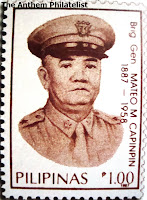The National Anthem of Haiti
 In 1893 a visiting warship to the Haitian capital was required by protocol to perform the Haitian anthem. Since Haiti did not yet have an anthem, the composer Occide Jeanty offered to compose music for the patriotic poem "Quand nos Aïeux brisèrent leurs entraves" written by Oswald Durand. This was completed that night and the anthem was debuted aboard the ship. It remained as an unofficial national anthem until a new one was chosen to mark Haiti's centennial on January 1, 1904. The former anthem still remains in use as a presidential salute.
In 1893 a visiting warship to the Haitian capital was required by protocol to perform the Haitian anthem. Since Haiti did not yet have an anthem, the composer Occide Jeanty offered to compose music for the patriotic poem "Quand nos Aïeux brisèrent leurs entraves" written by Oswald Durand. This was completed that night and the anthem was debuted aboard the ship. It remained as an unofficial national anthem until a new one was chosen to mark Haiti's centennial on January 1, 1904. The former anthem still remains in use as a presidential salute.The title of the national anthem "La Dessalinienne" (The Dessalines Song) honors the founder of Haiti, Jean-Jacques Dessalines. The anthem was selected as a result of a competition in 1903, the winning selection was adopted on the occassion of Haiti's centennial, January 1, 1904. The winning composer was Nicolas Geffrard and the writer Justin Lhérisson.
Jean-Jacques Dessalines (20 September 1758 – 17 October 1806) was a leader of the Haitian Revolution and the first ruler of an independent Haiti under the 1801 constitution. He was autocratic in his rule and crowned himself Emperor of Haïti in 1805. He also was a great-grandfather of Cincinnatus Leconte, who served as President of Haiti from 1911 to 1912. Beginning as Governor-General, Dessalines later named himself Emperor Jacques I of Haiti (1804–1806). He is remembered as one of the founding fathers of Haiti.

Dessalines served as an officer in the French army when the colony was trying to withstand Spanish and British incursions. Later he rose to become a commander in the revolt against France. As Toussaint L'Ouverture's principal lieutenant, he led many successful engagements, such as the Battle of Crête-à-Pierrot.
After the betrayal and capture of Toussaint Louverture in 1802, Dessalines became the leader of the revolution. He defeated French troops sent by Napoleon at the Battle of Vertières in 1803. Declaring Haiti an independent nation in 1804, Dessalines was chosen by a council of generals (blacks and mulattos) to assume the office of Governor-General. In September 1804, he proclaimed himself Emperor and ruled in that capacity until being assassinated in 1806.






